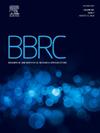模拟 SARS-CoV-1 融合核心的蛋白质可抑制 SARS-CoV-2 进入人体
IF 2.5
3区 生物学
Q3 BIOCHEMISTRY & MOLECULAR BIOLOGY
Biochemical and biophysical research communications
Pub Date : 2024-10-20
DOI:10.1016/j.bbrc.2024.150857
引用次数: 0
摘要
严重急性呼吸系统综合征冠状病毒 2(SARS-CoV-2)是 Betacoronavirus 属(Sarbecovirus 亚属)的成员,与严重急性呼吸系统综合征冠状病毒 1(SARS-CoV-1)在基因组和系统发育上有很大的相似性。SARS-CoV-2 感染是通过病毒与宿主细胞膜之间的膜融合发生的,穗糖蛋白亚基 2 (S2) 促进了这种融合。三个七重复区 1(HR1)折叠成一个中央三聚体核心结构,同时三个七重复区 2(HR2)以反平行方式结合在 HR1 区之间形成的沟槽中,这为膜融合提供了驱动力。在这项研究中,通过结合 SARS-CoV-2 HR1 和 HR2 的各种截断序列,产生了三聚体和单体六螺旋束(6HB)。此外,我们还用类似的方法构建了单体五螺旋束(5HB)。最后,我们展示了一种蛋白模拟物 5HB_V1(来自 SARS-CoV-1),它在抑制 SARS-CoV-2 方面表现出活性。这些发现提出了一种基于 SARS-CoV-2 融合核心设计单体 6HB 和 5HB 的策略:保留 HR2 中 α 螺旋区外的侧翼序列,并引入点突变以增强螺旋束之间的氢键。5HB 可作为设计新的 SARS-CoV-1 和 SARS-CoV-2 抑制剂的目标。本文章由计算机程序翻译,如有差异,请以英文原文为准。
Protein mimics of fusion core from SARS-CoV-1 can inhibit SARS-CoV-2 entry
Severe acute respiratory syndrome coronavirus 2 (SARS-CoV-2) is a member of the genus Betacoronavirus (subgenus Sarbecovirus) and shares significant genomic and phylogenetic similarities with severe acute respiratory syndrome coronavirus 1 (SARS-CoV-1). SARS-CoV-2 infection occurs through membrane fusion between the virus and host cell membranes, which is facilitated by the spike glycoprotein subunit 2 (S2). The folding of three heptad-repeat regions 1 (HR1) into a central trimeric core structure, along with the binding of three heptad-repeat regions 2 (HR2) in an antiparallel manner within the groove formed between the HR1 regions, which provides the driving force for membrane fusion. In this study, trimeric and monomeric six-helix bundles (6HB) were created by combining various truncations of the sequences from SARS-CoV-2 HR1 and HR2. In addition, monomeric five-helix bundles (5HB) were constructed using a similar method. Finally, we demonstrated a protein mimic, 5HB_V1 (from SARS-CoV-1), that exhibits activity in inhibiting SARS-CoV-2. These findings suggest a strategy to design monomeric 6HB and 5HB based on the SARS-CoV-2 fusion core: maintain the flanking sequences outside the α-helix region in HR2 and introduce point mutations to enhance hydrogen bonding between the helix bundles. The 5HB could be a target for designing new inhibitors against SARS-CoV-1 and SARS-CoV-2.
求助全文
通过发布文献求助,成功后即可免费获取论文全文。
去求助
来源期刊
CiteScore
6.10
自引率
0.00%
发文量
1400
审稿时长
14 days
期刊介绍:
Biochemical and Biophysical Research Communications is the premier international journal devoted to the very rapid dissemination of timely and significant experimental results in diverse fields of biological research. The development of the "Breakthroughs and Views" section brings the minireview format to the journal, and issues often contain collections of special interest manuscripts. BBRC is published weekly (52 issues/year).Research Areas now include: Biochemistry; biophysics; cell biology; developmental biology; immunology
; molecular biology; neurobiology; plant biology and proteomics

 求助内容:
求助内容: 应助结果提醒方式:
应助结果提醒方式:


